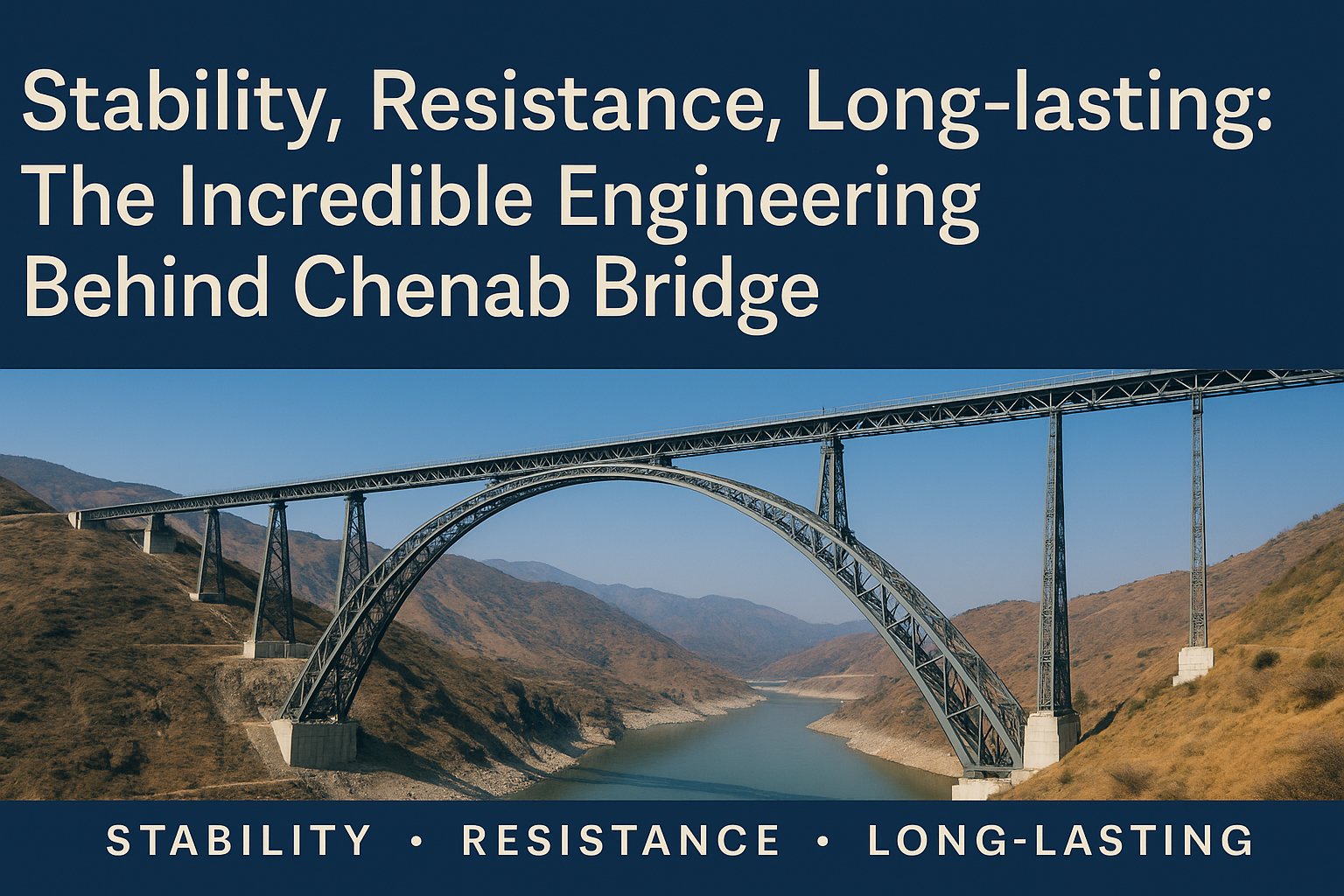Stability, Resistance, Long-lasting: The Incredible Engineering Behind Chenab Bridge
Introduction
The Chenab Bridge, a marvel of modern engineering, stands as a testament to India’s infrastructural prowess. Spanning the Chenab River in Jammu and Kashmir, this bridge is not just the world’s highest railway arch bridge, but also a symbol of stability, resistance, and long-lasting durability. Engineered to withstand extreme environmental and geological challenges, the Chenab Bridge redefines what’s possible in bridge construction in hostile terrains.
A Quick Overview of the Chenab Bridge
Location: Reasi district, Jammu & Kashmir, India
Height: 359 meters (1,178 feet) above riverbed level
Length: 1,315 meters
Purpose: Connects the Kashmir Valley with the rest of India via rail
Completion Year: 2022 (structural completion)
Stability: Designed to Endure
One of the most critical aspects of the Chenab Bridge is its structural stability. Engineers from Indian Railways and Konkan Railway Corporation used wind tunnel testing, seismic assessments, and geological surveys to ensure the bridge remains stable across extreme conditions. Its arch design helps distribute load evenly and reduces the stress on its piers.
Key Stability Features:
Steel truss arch structure ensures minimal stress concentration
Ballastless tracks provide enhanced track stability
Use of open web girders reduces overall dead weight
Resistance: Built to Face the Extremes
Resistance against natural forces was non-negotiable. The region is prone to:
High seismic activity
Strong wind pressures (up to 266 km/h)
Extreme temperatures (from -20°C to +45°C)
To counter these, the Chenab Bridge incorporates:
Seismic dampers to absorb shock from earthquakes
Wind-resistant design, validated via computational fluid dynamics (CFD)
Weathering steel, which resists corrosion and performs well in fluctuating climates
Long-lasting: A Legacy of Generations
The expected lifespan of the Chenab Bridge is 120+ years. It has been designed to require minimal maintenance and offers resilience against aging through:
Advanced corrosion protection on steel components
Thermal insulation against extreme temperatures
Monitoring systems that continuously assess structural health
Moreover, the bridge’s foundation goes deep into the Himalayan bedrock, ensuring long-term endurance even against river-induced soil erosion.
Engineering Innovations Behind Chenab Bridge
Cable cranes spanning 915 meters were used to erect the central arch, a first in India
Robotic welding techniques ensured precision and reduced human error
Real-time monitoring systems (Structural Health Monitoring System – SHMS) are installed to detect early signs of fatigue
Impact on India’s Infrastructure
The Chenab Bridge is not just an engineering wonder—it’s a geopolitical asset that:
Enhances connectivity in the Kashmir Valley
Supports economic development through better logistics
Boosts strategic mobility for defense and emergency services
FAQs
Q1. Why is the Chenab Bridge considered the world’s highest railway bridge?
It stands at a height of 359 meters above the Chenab River—35 meters taller than the Eiffel Tower—making it the highest railway bridge globally.
Q2. What materials were used in its construction?
High-tensile steel, concrete, and weathering-resistant alloys were used, all suited for high-altitude and seismic-prone environments.
Q3. How long did it take to complete the bridge?
Planning and construction spanned nearly two decades due to the geographical and climatic challenges.
Q4. Can the bridge withstand earthquakes?
Yes, it is built to withstand earthquakes up to Zone V seismic activity, the highest level on the Indian scale.
Q5. What makes the bridge long-lasting?
A combination of innovative design, high-quality materials, and advanced protective systems ensures its longevity.
Conclusion
The Chenab Bridge is more than just a railway link—it’s a feat of engineering that harmonizes stability, resistance, and endurance. It showcases India’s capability to execute world-class infrastructure even in the most challenging terrains. As a structure built to last generations, the Chenab Bridge stands tall—literally and figuratively—as a symbol of engineering excellence.






